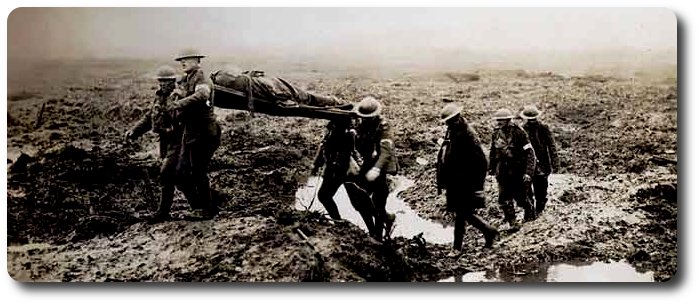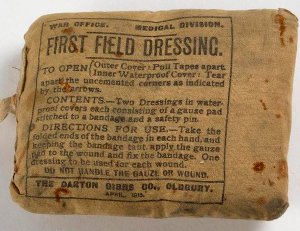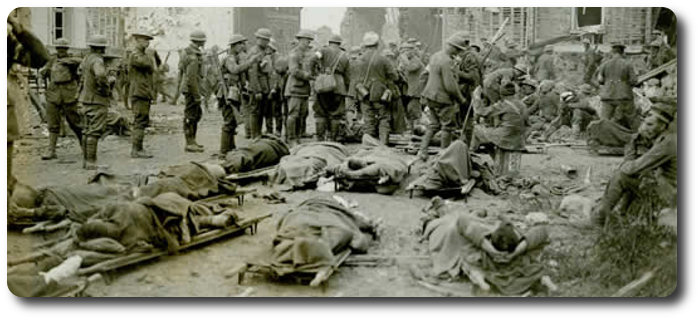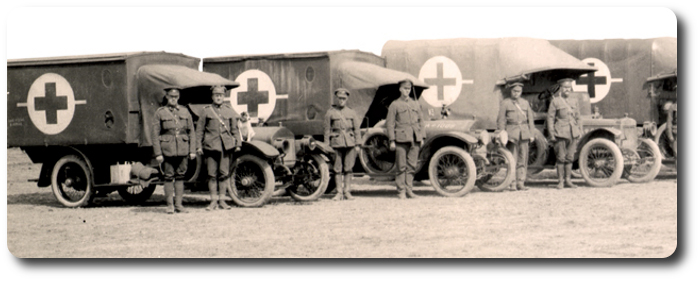Topic: CEF

General System of Dealing with Casualties in Action
Field Service Regulation, Part II
Organization and Administration, 1909
(Amendments to October 1914)
Chapter XI—The Medical Services
Article 90
 1. Every officer and man will carry on a string round his neck an identity disc showing his name, number if any, unit and religion. He will also carry a first field dressing in the right hand skirt pocket of his coat. Both disc and dressing should be frequently inspected.
1. Every officer and man will carry on a string round his neck an identity disc showing his name, number if any, unit and religion. He will also carry a first field dressing in the right hand skirt pocket of his coat. Both disc and dressing should be frequently inspected.
2. In action against a civilized enemy, no one other than a stretcher bearer is to carry a wounded man to the rear, unless ordered to do so.
3. Ammunition will, when practicable, be taken from wounded men before they are sent to the rear, and will be disposed on under the order of the divisional commander. Otherwise arms, ammunition, accoutrements, and personal kit of sick and wounded men will be taken to hospital along with the men. Arms, &c., not required for patients, will be periodically handed over by hospitals to ordnance depots.
4. Wounded men will be attended to in the first instance by the medical establishment of the unit, and will afterwards be removed by the field ambulance.
5. The first field dressing applies as a protection against dirt and to stop hemorrhage, with the addition of some support to a broken limb, before removal of the patient, is all that is needed on the field itself. After this first aid a wounded man should be left where he lies, under as good cover as possible, unless the nature of the ground, a pause in the fighting, or the approach of darkness allows systematic collection and removal.
6. The field ambulance of a division will operate over the areas allotted to them according to the arrangements made by the assistant director of medical services of the division. Their first duty is to establish touch by means of their bearer divisions with the regimental medical service of the units in the area assigned to them, to observe the position of casualties, and to obtain information regarding the places where wounded have been left under cover. The ambulance wagons are then brought as far forward as possible, and the stretcher squads carry the wounded to them.
7. Cases able to walk will be directed to the divisional collecting station, which is a well-defined spot previously selected for the purpose and notified to the medical personnel concerned by the assistant director of medical services of the division.

8. A tent sub-division may be sent forward with sufficient equipment to form an advanced dressing station, where th more seriously wounded are brought to the ambulance wagons by the stretcher squads. The rest of the tent divisions will remain in rear, and open there as a link between the advanced dressing station and the clearing hospital; or they may be sent forward to expend the advanced dressing station, according to circumstance.
9. In order that as many sections as possible may be in hand to meet developments, the principle should be observed of not opening more sections of ambulances than are absolutely necessary until the locality is known where the number of casualties is greatest. One section at least should be held in reserve to the last to provide for a counter-attack.
10. The work of removing wounded during actual fighting must be left to the initiative of commander of the field ambulances, and to the medical service with regimental units. The assistant director of medical services is mainly concerned in issuing orders relative to the opening or closing of the ambulances and in maintaining connection between them and the clearing hospitals; for this purpose he will indicate to all concerned the place to which the dressing stations of the tent divisions should send back the wounded. If a detachment from a clearing hospital is not available one or more tent divisions of a field ambulance should be detailed to this spot. From the ambulances all except very slight cases, for discharge to duty within two days, will be sent to clearing hospitals as soon as possible.
11. It is of great importance that information regarding the situation, as affecting the number of the casualties and the area where they are occurring, should constantly be transmitted between brigade and divisional headquarters in order to enable the assistant directors of medical services with divisions to regulate the movements of the field ambulances.
12. The main work of clearing the area of operations of the wounded takes place after a battle. Under the orders of the commander, arrangements are made by the A.G's branch of the staff, after consultation with that of the Q.M.G. and with the General Staff, for the collection of the wounded whom the regimental medical service and bearer divisions of the ambulances were unable to bring in during the progress of the battle. It may be found necessary to detail special detachments of fighting troops to aid in this work, while, whenever it is possible without interfering with military operations, all units in the vicinity of a battlefield should, after an action, search the ground in their neighbourhood for wounded, and render such assistance as may be in their power. One or more control points, usually where dressing stations have been placed, should be selected for collection of wounded, and systematic search made of the whole area, a portion being alotted to each search paty, which should be accompanied by a medical officer, a proportion of stretcher squads and one or more ambulance wagons.
13. Arrangements for evacuation of the wounded to the L. of C. are the duty of the Q.M.G's branch of the staff, the A.G's branch being informed of the dispositions made for this purpose.


